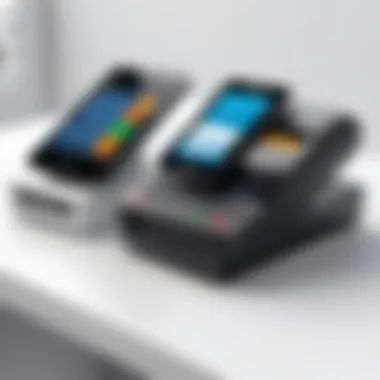Exploring SoftPOS Providers in B2B Transactions


Intro
The landscape of payment processing is evolving rapidly, especially with the advent of SoftPOS technology. This shift is particularly significant in the B2B sector, where transactions can often be complex and multi-faceted. Understanding SoftPOS providers and their impact on B2B transactions is crucial for decision-makers who seek efficiency and cost-effectiveness. This article aims to dissect this emerging trend, shedding light on its implications and advantages.
Key Features
Overview of Features
SoftPOS solutions represent a pivotal shift in the way businesses handle payments. Unlike traditional point-of-sale systems that rely on dedicated hardware, SoftPOS allows smartphones and tablets to function as payment acceptance devices. The main features include:
- NFC Technology: Near Field Communication enables fast, contactless transactions between devices. This is particularly relevant in environments where speed and convenience are paramount.
- Enhanced Security: SoftPOS providers typically incorporate robust security measures, like encryption and tokenization, to protect sensitive transaction information.
- Integration Capabilities: Many SoftPOS solutions offer seamless integration with existing business systems, such as inventory management and customer relationship management platforms.
- User-Friendliness: The interface of SoftPOS apps is designed for simplicity, allowing staff to process payments quickly with minimal training.
Unique Selling Propositions
The unique selling propositions of SoftPOS technology can greatly influence a company’s payment strategy. These solutions offer:
- Lower Costs: By eliminating the need for special hardware, businesses can reduce their upfront and ongoing costs.
- Scalability: SoftPOS solutions can easily adapt as a business grows or changes, enabling companies to keep pace with evolving market dynamics without significant additional investment.
- Flexibility: Businesses can accept payments anywhere, which is particularly beneficial for those with mobile workforces or that operate in various locations.
"The ability to turn any device into a payment terminal is a game-changer for B2B transactions, enhancing efficiency and customer satisfaction."
Pricing Models
Different Pricing Tiers
Understanding the pricing models associated with SoftPOS solutions is essential for businesses considering adoption. Typically, these providers offer various pricing tiers, which may include:
- Subscription-Based Models: Regular subscription fees that include updates and support.
- Pay-Per-Transaction: Charges applied with every transaction processed, ideal for businesses with fluctuating sales volumes.
- One-Time Licensing Fees: A singular cost for perpetual licensing of the software, suitable for larger enterprises.
ROI and Cost-Benefit Analysis
Assessing the return on investment for a SoftPOS solution involves analyzing cost savings, efficiencies gained, and enhanced customer experience. Businesses should consider:
- Reduction in Hardware Costs: Savings from not needing traditional POS equipment.
- Increased Transaction Speed: Faster payment processing can improve cash flow and customer satisfaction.
- Operational Efficiency: Less time spent on transactions can free up resources for other important business activities.
Understanding SoftPOS Technology
Understanding SoftPOS technology is essential for organizations looking to innovate their payment processing systems. It is a crucial topic for companies aiming to enhance efficiency and improve customer experiences in their B2B transactions. SoftPOS solutions represent a paradigm shift in the way businesses handle transactions. They eliminate the need for expensive hardware and allow transactions to be completed through existing mobile devices. This flexibility is particularly valuable in a rapidly changing market.
What is SoftPOS?
SoftPOS, or Software Point of Sale, refers to a software-based solution that allows merchants to process payments using mobile devices without dedicated POS hardware. With SoftPOS, any device equipped with Near Field Communication (NFC) technology can function as a payment terminal. Essentially, businesses can utilize smartphones or tablets to conduct transactions seamlessly. This approach reduces the costs associated with traditional POS systems and offers a more agile solution for processing payments.
Key Features of SoftPOS Solutions
SoftPOS solutions come with several key features that distinguish them from traditional payment systems:
- NFC Capability: This enables contactless payments from compatible cards and mobile applications.
- Cost Efficiency: As mentioned, using existing mobile devices cuts down on the need for purchasing additional hardware.
- Ease of Integration: Many SoftPOS solutions can easily integrate with existing software ecosystems, supporting ERP or accounting tools.
- User-friendly Interface: A well-designed interface enhances the customer experience, making transactions quick and uncomplicated.
Among these features, the ability to accept various payment types, including credit cards and digital wallets, stands out as an important aspect for B2B transactions.
How SoftPOS Differs from Traditional POS
SoftPOS differs fundamentally from traditional POS systems in several ways.
- Hardware Dependency: Traditional POS systems necessitate specific hardware that can be costly. In contrast, SoftPOS relies on universal devices, typically smartphones or tablets, which are already in use by many businesses.
- Mobility: SoftPOS allows for on-the-go transactions, enhancing the convenience factor. Traditional systems usually require interaction at a fixed location.
- Implementation: Setting up a SoftPOS solution can be quicker and easier, as businesses can adapt existing devices rather than waiting for hardware to be delivered and configured.
In essence, SoftPOS reshapes the landscape of payment processing by making it more accessible and efficient. As companies increasingly turn to digitization, SoftPOS emerges as a viable solution designed to meet the evolving demands of the market.
"The evolution of payment processing systems does not lie solely in cutting-edge technology; it also encompasses the adaptability and cost-effectiveness that SoftPOS solutions offer."


The Role of SoftPOS in B2B Transactions
The emergence of SoftPOS technology is reshaping payment dynamics within the B2B ecosystem. Understanding its role requires an exploration of its adoption trends and the multifaceted impacts it brings to payment processing. SoftPOS simplifies and modernizes payment solutions, allowing businesses to engage with a wide array of transactions. As B2B transactions become more reliant on technology, the relevance of SoftPOS solutions escalates. Businesses no longer need separate hardware solutions to accept payments, facilitating a shift towards efficiency and convenience.
Adoption Trends in the B2B Sector
The adoption of SoftPOS technology in the B2B sector is gaining momentum. Companies are increasingly recognizing the advantages of mobile payment solutions. Data indicates a significant uptick in the number of B2B transactions processed through SoftPOS systems. Key drivers include the need for cost-effective solutions, improved cash flow management, and the desire for increased transaction transparency.
Many businesses are shifting from traditional payment methods due to the high costs associated with legacy POS systems. For example, SoftPOS allows companies to utilize existing smartphones or tablets, which reduces the need for extensive hardware investments. Additionally, the COVID-19 pandemic accelerated the trend towards contactless and remote payments, making SoftPOS solutions even more attractive.
Overall, the trend shows that businesses are becoming more adaptable to digital solutions, paving the way to more innovative B2B transaction methodologies.
Impacts on Payment Processing
The impact of SoftPOS on payment processing in B2B transactions can be particularly profound. Processes that previously required multiple layers of authorization are being streamlined. SoftPOS empowers businesses to accept payments directly through their devices.
This technology enhances efficiency and reduces transaction times, which is crucial for companies engaged in high-volume environments. Further, the seamless integration of SoftPOS with existing financial systems enables real-time tracking of payments, simplifying accounting tasks. This integration often leads to reduced errors, enabling teams to focus on core business functions.
Moreover, SoftPOS can support various payment methods, whether it involves credit cards, mobile wallets, or QR code transactions. As a result, it broadens the scope of payment options available to suppliers and clients alike.
"SoftPOS technology transforms how businesses engage in transactions. By eliminating the need for extensive hardware, it paves the way for innovation."
While there are substantial benefits, organizations should also consider potential challenges in integrating SoftPOS into their existing systems. Awareness and proper implementation are key factors that influence the successful adoption of this technology. Ultimately, the role of SoftPOS in B2B transactions extends beyond mere convenience; it represents a fundamental shift towards new operational efficiencies.
Evaluating SoftPOS Providers
Evaluating SoftPOS providers is a critical step for businesses looking to enhance their payment processes. The selection of an appropriate SoftPOS solution can significantly influence transaction efficiency, cost-effectiveness, and overall user satisfaction. Today, organizations are increasingly turning towards digital solutions, and understanding the key factors that distinguish SoftPOS providers is essential for informed decision-making. This evaluation helps businesses identify a provider that aligns not only with their operational needs but also with their long-term strategic goals.
Leading SoftPOS Providers in the Market
The market for SoftPOS solutions has become increasingly competitive. Some of the notable providers include:
- Square: Known for its ease of use and integration capabilities, Square offers a wide range of services that appeal to many B2B businesses.
- PayPal Zettle: This platform enables straightforward transactions and is particularly favored for its strong reputation in security.
- Adyen: This provider stands out with its extensive global reach and vast array of payment methods.
- SumUp: Focused primarily on small businesses, SumUp provides accessible and affordable solutions.
- Worldpay: This provider is recognized for robust features tailored for larger enterprises.
Each of these providers offers distinct advantages, making it essential for businesses to consider their specific needs and environments when evaluating options.
Comparative Analysis of Features
When comparing SoftPOS providers, several features must be taken into account:
- User Interface: An intuitive interface reduces training time and enhances transaction speed.
- Integration Compatibility: This ability potentially saves costs and resources. Some solutions offer better compatibility with existing systems like ERP or inventory management software.
- Security Measures: Understanding the security protocols that providers implement is crucial to safeguard transactions.
- Customer Support: Efficient support services are vital in case problems arise post-implementation.
- Customization Options: Providers that allow businesses to tailor features to meet their needs can offer significant advantages.
A thorough analysis of these features allows businesses to assess which SoftPOS solution meets their criteria best.
Pricing Models Across Providers
Different SoftPOS providers offer various pricing models, impacting the total cost of ownership. Common pricing structures include:
- Flat Fees: Some providers charge a flat transaction fee, which may simplify budgeting but can also become costly for high-volume transactions.
- Percentage-based Fees: These adjust according to sales volume. This model is common but can lead to higher costs during peak sales periods.
- Subscription Basis: This model includes a monthly or annual fee, which can provide certainty for budgeting.
- Pay-as-you-go: Here, businesses pay only for the services they use, making it potentially more flexible.
Ultimately, businesses must weigh the pricing against projected transaction volumes and anticipated growth. Selecting the right pricing model will have lasting implications on profit margins and operational fluidity.
Security Considerations for SoftPOS
The growing adoption of SoftPOS solutions in B2B transactions brings various security concerns to the forefront. As businesses increasingly rely on these systems for payment processing, understanding the security implications is crucial. Effective security measures protect sensitive data and maintain trust between vendors and clients. The integration of SoftPOS must prioritize security features in order to defend against potential threats.
Understanding Security Protocols
Security protocols govern the transmission of data from SoftPOS devices to payment processors. These protocols include encryption methods that safeguard sensitive information during transactions. For instance, utilizing technologies like Secure Socket Layer (SSL) and Transport Layer Security (TLS) ensures that data is encrypted and remains confidential.
Key elements of these protocols include:


- Data Encryption: Converts sensitive data into a coded format to prevent unauthorized access.
- Authentication Measures: Verifies identity before allowing access to payment processing systems.
- Tokenization: Replaces sensitive data with tokens that can only be reversed by authorized systems.
When evaluating SoftPOS solutions, it is important to confirm that stringent security protocols are embedded within the system. This step aids businesses in mitigating risks such as data breaches or fraud.
Regulatory Compliance and Standards
Complying with regulatory frameworks is non-negotiable for businesses deploying SoftPOS solutions. Standards such as the Payment Card Industry Data Security Standard (PCI DSS) set the benchmark for security in payment processing. Adhering to these regulations protects organizations from potential legal repercussions and helps ensure customer trust.
Several compliance elements to consider include:
- Regular Security Assessments: Regularly evaluating security measures helps identify and remediate vulnerabilities.
- Incident Response Plans: Developing plans for responding to security breaches prepares businesses for rapid action.
- Staff Training: Employees must be educated on security protocols to recognize and report suspicious activities effectively.
Following established standards fosters an environment of security, reducing risks associated with payment processing and enhancing the reputation of SoftPOS providers. This commitment to security is essential for sustaining long-term business relationships.
Integrating SoftPOS with Existing Systems
Integrating SoftPOS with existing systems is crucial for businesses aiming to enhance their payment processes and manage transactions efficiently. As SoftPOS technology gains traction, its seamless connection to current systems becomes a priority. This integration not only facilitates smoother operational workflows but also maximizes the potential of SoftPOS solutions within a company's infrastructure.
Compatibility with ERP Systems
Enterprise Resource Planning (ERP) systems play a significant role in managing business functions by integrating various processes. Therefore, ensuring that SoftPOS solutions are compatible with ERP systems is essential. The integration enables real-time data synchronization, making it easier to manage inventory, supply chain, and customer relationships.
- Enhanced visibility into cash flow and transaction history.
- Reduction of data entry errors through automated updates.
- Streamlined auditing processes with centralized transaction records.
By linking SoftPOS with ERP systems, decision-makers can enable a more cohesive financial monitoring approach. It reduces manual work, which can lead to significant time savings. As a result, companies can focus on strategic objectives rather than administrative tasks.
Challenges in Integration
Despite the advantages, the integration of SoftPOS with existing systems can present challenges. Some of the most common issues include:
- Data Migration Difficulties: Moving data from old systems to the new SoftPOS can be complex and prone to errors.
- Scalability Concerns: Ensuring the SoftPOS solution can scale with the business as it grows is critical.
- Training Requirements: Staff may need training to familiarize themselves with new processes.
- Compatibility Issues: Not all SoftPOS providers have the same level of integration capabilities, which can lead to operational risks.
Companies must prepare to address these challenges proactively. Identifying the right SoftPOS provider that offers comprehensive support and robust integration tools can make the transition smoother. By doing thorough due diligence, businesses can mitigate integration risks and capitalize on the efficiency offered by SoftPOS technology.
The success of SoftPOS implementation hinges on its compatibility with existing systems and overcoming integration challenges, making it vital for businesses to strategize their approach carefully.
The future effectiveness of SoftPOS solutions in the B2B landscape relies heavily on how well they integrate into the existing ecosystem. Organizations that prioritize this aspect will find themselves ahead in the competitive market.
User Experience and Interface Design
User experience (UX) and interface design play a crucial role in the effectiveness of SoftPOS solutions. A streamlined user interface is essential, especially in a business-to-business environment where efficiency can significantly impact productivity. Businesses often require systems that offer rapid transactions without compromise on security or functionality. A well-designed interface minimizes the learning curve for employees, reducing operational downtime during the onboarding process. Moreover, an intuitive design can improve customer interaction during payment processes, leading to a smoother overall experience.
Importance of a User-friendly Interface
A user-friendly interface is the cornerstone of effective SoftPOS technology. Specific elements such as clear navigation, easy-to-read text, and responsive design can enhance user engagement. These features ensure that staff can quickly process transactions, thus decreasing wait times. This reduction in wait time can positively affect customer satisfaction, leading to repeat business and customer loyalty.
Several benefits arise from prioritizing a user-friendly interface:
- Increased Adoption Rates: Employees are more likely to embrace new technology that they can grasp easily.
- Error Reduction: A clear interface minimizes the likelihood of mistakes during transactions.
- Time Efficiency: Simplified operations can lead to faster transaction times, which is crucial in high-volume business settings.
Customization Options for Businesses
Customization is another pivotal aspect of SoftPOS solutions that can directly influence user experience. Businesses often have diverse needs that require tailored solutions rather than one-size-fits-all products. Custom features may include branding, transaction settings, and specific functionalities that align with business protocols.
Considerations for Customization
- Brand Integration: Companies want to present a cohesive image. Customizable interfaces allow businesses to incorporate their brand logos and color schemes within the SoftPOS application.
- Flexibility in Features: Having the ability to choose specific functionalities is invaluable. Some businesses may require more advanced reporting tools or features for managing subscriptions.
- User Feedback in Design: Encouraging feedback from actual users can guide enhancements that meet real-world needs rather than theoretical ones.
"Customization transforms a product from being just a tool to an integral part of the business strategy."


Case Studies of Successful Implementations
Analyzing case studies of successful SoftPOS implementations provides valuable insights into how these solutions function in the real world. These examples are not just anecdotal; they demonstrate tangible benefits and highlight best practices for integration and usage in a variety of business contexts.
Understanding these use cases is essential for organizations considering SoftPOS as a part of their payment processing strategy. Each case reflects unique challenges, solutions, and outcomes that inform decision-makers on expected results when adopting SoftPOS technology.
Industry-specific Use Cases
- Retail Sector
Retail businesses, especially those with high transaction volumes, have benefitted significantly from SoftPOS solutions. For instance, Square has successfully implemented SoftPOS for numerous pop-up shops and small businesses. This allows merchants to accept payments directly through smartphones without additional hardware, translating to reduced setup time and costs. Many retailers have reported an increase in sales due to the convenience SoftPOS provides. - Hospitality Industry
In the hospitality sector, SoftPOS has transformed the dining experience. Toast, a leading restaurant management software, has integrated SoftPOS to improve customer service. Servers can take payments directly at the table, reducing wait time and enhancing customer satisfaction. This has led to improved cash flow for restaurants as it decreases the time between service and payment. - Transportation Services
Transportation companies, such as Uber, utilize SoftPOS to facilitate cashless transactions. This enables drivers to quickly accept fares directly through their mobile devices, streamlining the payment process and increasing efficiency. SoftPOS has made it easier for users to pay without needing cash, aligning with the trend towards digital transactions.
Testimonials from Business Leaders
Incorporating insights from business leaders who have implemented SoftPOS adds depth to understanding its impact. Testimonials often highlight both the advantages and challenges faced during adoption.
"Transitioning to SoftPOS has been one of our best decisions. With Zettle, we cut down on costs and improved our customer service. The flexibility it offers to our staff is unmatched."
– James, Owner of a Small Retail Shop
Leaders emphasize three key benefits:
- Cost Efficiency: Many businesses report lower upfront costs compared to traditional POS systems, which often require expensive hardware.
- Scalability: SoftPOS solutions easily scale with the business as it grows, allowing for quick addition of features or capabilities as needed.
- Customer Satisfaction: Quick payments and reduced wait times have directly contributed to higher levels of customer satisfaction across various industries.
Future Trends in SoftPOS Solutions
The future of SoftPOS solutions is poised for significant transformation. As businesses continue adapting to the digital landscape, understanding the emerging trends in SoftPOS becomes crucial. These trends not only reflect technological innovations but also influence how businesses engage with payment systems. Organizations adopting advanced SoftPOS can streamline transactions, improve efficiency, and enhance customer experiences.
Technological Advancements to Watch
Several technological advancements are shaping the future of SoftPOS solutions. First, mobile payment technologies will continue to evolve. Enhanced Near Field Communication (NFC) capabilities enable users to make transactions quickly and securely. This brings convenience for B2B transactions, where speed and security are paramount.
Second, the integration of biometric authentication is becoming more prevalent. Solutions that leverage fingerprint or facial recognition add a layer of security that traditional methods lack. Increasing digital threats necessitate a focus on strong authentication methods.
Additionally, cloud-based SoftPOS systems are gaining traction. These solutions offer scalability and flexibility, allowing businesses to adapt their payment systems as they grow. Companies can access transaction data and analytics more easily, informing decision-making and strategic planning.
"The integration of technology will determine how smoothly transactions run. Companies need to stay ahead to remain competitive."
Finally, artificial intelligence and machine learning are being incorporated into SoftPOS providers. These technologies can analyze transaction data to identify trends, detect fraud, and enhance customer service. By leveraging data, businesses can better understand their customers and tailor solutions to meet their needs.
Potential Market Shifts
The evolution of SoftPOS is also likely to spark significant market shifts. As more businesses adopt SoftPOS solutions, there will be a marked increase in competition among providers. This competition can lead to lower costs and improved services, benefiting businesses of all sizes.
Furthermore, traditional payment processors may re-evaluate their offerings in response to the rise of SoftPOS. Companies like Square and PayPal have already started expanding their services to integrate SoftPOS capabilities. This indicates a shift in how payment processing is perceived.
Lastly, regulatory changes may also impact the SoftPOS landscape. As governments recognize the importance of secure payment methods, they may implement guidelines that encourage the use of SoftPOS solutions. Businesses that adapt to these regulatory landscapes can position themselves favorably within their markets.
Finale and Final Recommendations
The relevance of SoftPOS solutions in the contemporary B2B landscape cannot be understated. Businesses recognize the necessity of modernizing their payment systems to keep up with rapid advancements in technology and changing consumer preferences. The analysis presented throughout this article illuminates critical aspects of SoftPOS technology, its benefits over traditional systems, and its significant role in reshaping B2B transactions. In synthesizing these insights, decision-makers can gauge the impact and suitability of SoftPOS for their individual needs.
Utilizing SoftPOS technology can enhance operational efficiency. It eliminates the necessity for expensive hardware, reduces the time spent on payment processing, and aids in streamlining customer transactions. The portability of SoftPOS is a distinct advantage; businesses can easily accept payments wherever they interact with clients. Given the dynamic environment of B2B transactions, this flexibility is integral to meeting client demands effectively.
Moreover, security remains a top consideration. As providers continue to evolve their offerings to include enhanced encryption and compliance measures, understanding these elements is crucial when evaluating different SoftPOS solutions. Therefore, businesses must weigh security considerations alongside usability and cost.
Investing in SoftPOS technology is not merely an operational adjustment but a strategic move towards sustaining competitiveness in an increasingly digital marketplace.
In closing, businesses contemplating the adoption of SoftPOS should conduct thorough evaluations of providers. They must consider not only the immediate benefits but also the long-term implications. A strategic approach should prioritize solution compatibility with existing systems, transaction volumes, and the specific challenges that each business seeks to address.
Summarizing Key Takeaways
- Understanding SoftPOS technology is essential, as it represents a shift in how transactions are processed in the B2B sector.
- SoftPOS systems offer significant advantages over traditional POS solutions, including reduced costs and improved flexibility.
- The increased portability allows businesses to engage customers in various settings, enhancing their payment capabilities.
- Security remains a focal point. Businesses should invest time in understanding security protocols and compliance requirements.
- Future trends will likely continue influencing the evolution of SoftPOS, meaning businesses must stay informed to remain competitive.
Guidance for Decision Makers
Decision-makers must approach SoftPOS adoption with a comprehensive strategy:
- Evaluate the current payment processing systems in place and identify areas for improvement.
- Research multiple SoftPOS providers to understand feature sets, pricing models, and support options.
- Consider integration capabilities with existing ERP and financial systems to avoid disruption during the transition.
- Seek feedback and case studies from organizations within the same industry to gauge real-world effectiveness.
- Analyze long-term financial implications of switching to SoftPOS, including potential savings on hardware and transaction fees.
In summary, careful considerations and strategic evaluations will empower decision-makers to harness the advantages of SoftPOS effectively while minimizing risks linked to new technology adoption.















